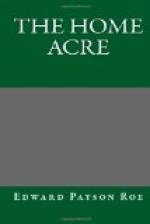In order to insure an unfailing supply of this delicious fruit, I should advise that a few trees be set out every spring. The labor and expense are scarcely greater than that bestowed upon a cabbage patch, and the reward is more satisfactory.
For this latitude the following choice of varieties will prove, I think, a good one: Early Alexander, Early Elvers, Princess of Wales, Brandywine, Old Mixon Free, Stump the World, Picquet’s Late, Crawford’s Late, Mary’s Choice, White Free Heath, Salway, and Lord Palmerston.
If the soil of one’s garden is stiff, cold, adhesive clay, the peach would succeed much better budded or grafted on plum-stocks. Some of the finest fruit I have ever seen was from seedlings, the trees having been grown from pits of unusually good peaches. While the autumn planting of pits lightly in the soil and permitting them to develop into bearing trees is a pleasing and often profitable amusement, there is no great probability that the result will be desirable. We hear of the occasional prizes won in this way, but not of the many failures.
By easy transition we pass to the kindred fruit the plum, which does not generally receive the attention it deserves. If one has a soil suited to it—a heavy clay or loam—it can usually be grown very easily. The fruit is so grateful to the taste and useful to the housekeeper that it should be given a fair trial, either in the garden borders or wherever a tree can be planted so as to secure plenty of light and air. The young trees may be one or two years old from the bud; I should prefer the former, if vigorous. Never be induced to purchase old trees by promises of speedy fruit. It is quite possible you may never get any fruit at all from them worth mentioning. I should allow a space of from ten to fifteen feet between the trees when they are planted together, and I should cut them back so that they would begin to branch at two feet from the ground. Long, naked stems are subject to the gum-disease.
In the place of general advice in regard to this fruit I shall give the experience of Mr. T. S. Force, of Newburgh, who exhibited seventy varieties at the last annual Orange County fair.
His plum-orchard is a large poultry-yard, containing half an acre, of which the ground is a good loam, resting on a heavy clay subsoil. He bought trees but one year from the bud, set them out in autumn, and cut them back so that they began to form their heads at two feet from the ground. He prefers starting with strong young plants of this age, and he did not permit them to bear for the first three years, his primal aim being to develop a healthy, vigorous tree with a round, symmetrical head. During this period the ground about them was kept mellow by good cultivation, and, being rich enough to start with, received no fertilizers. It is his belief that over-fertilization tends to cause the disease so well known as the “black knot,” which has destroyed many orchards in this vicinity.




